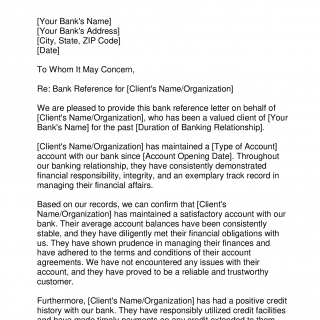Bank Reference Letter
The Bank Reference Letter is a letter from a bank that confirms the financial status and history of an individual or organization. The main purpose of this letter is to provide information about the individual's or organization's financial stability, creditworthiness, and account history to a third party, such as a potential creditor or business partner.
The letter typically consists of the following parts:
- Salutation: Begin the letter with a professional greeting, addressing the recipient by name or using a general salutation like "To Whom It May Concern."
- Introduction: In the opening paragraph, state the purpose of the letter and provide an introduction to the individual or organization being referenced. Mention the name of the account holder, the type of account (e.g., personal or business), and the duration of the banking relationship.
- Account History: In the body of the letter, provide an overview of the individual's or organization's account history with the bank. Include details such as account opening date, account type, average balances, and any outstanding loans or credit facilities held with the bank. Highlight their financial stability and ability to manage their accounts responsibly.
- Creditworthiness: Discuss the individual's or organization's creditworthiness and repayment history. Mention any credit facilities, loans, or lines of credit that have been extended to them by the bank and their payment history. Emphasize their reliability in meeting their financial obligations.
- Financial Stability: Provide an assessment of the individual's or organization's financial stability. This can include mentioning their financial standing, their ability to generate income or revenue, and any notable financial achievements or milestones. Emphasize their positive financial track record and ability to manage their finances effectively.
- Conclusion: Conclude the letter by expressing confidence in the individual's or organization's financial stability and credibility. Offer contact information should the recipient have any further questions or require additional information.
Sample of Bank Reference Letter
[Your Bank's Name]
[Your Bank's Address]
[City, State, ZIP Code]
[Date]To Whom It May Concern,
Re: Bank Reference for [Client's Name/Organization]
We are pleased to provide this bank reference letter on behalf of [Client's Name/Organization], who has been a valued client of [Your Bank's Name] for the past [Duration of Banking Relationship].
[Client's Name/Organization] has maintained a [Type of Account] account with our bank since [Account Opening Date]. Throughout our banking relationship, they have consistently demonstrated financial responsibility, integrity, and an exemplary track record in managing their financial affairs.
Based on our records, we can confirm that [Client's Name/Organization] has maintained a satisfactory account with our bank. Their average account balances have been consistently stable, and they have diligently met their financial obligations with us. They have shown prudence in managing their finances and have adhered to the terms and conditions of their account agreements. We have not encountered any issues with their account, and they have proved to be a reliable and trustworthy customer.
Furthermore, [Client's Name/Organization] has had a positive credit history with our bank. They have responsibly utilized credit facilities and have made timely payments on any credit extended to them. Their creditworthiness is reflected in their prompt repayment and adherence to the terms of any loans or lines of credit they have held with our institution. We have found them to be creditworthy and reliable in meeting their financial obligations.
In terms of financial stability, [Client's Name/Organization] has demonstrated prudence and managed their finances astutely. They have exhibited strong financial standing, which is evident in their ability to meet their financial commitments and generate income/revenue.
Based on our relationship with [Client's Name/Organization], we have found them to be a reputable and responsible entity/individual with a positive financial track record. We believe they possess the necessary financial stability, credibility, and integrity to fulfill their financial obligations and participate in various financial transactions.
If you require any further information or have any specific questions regarding [Client's Name/Organization]'s account history or financial suitability, please do not hesitate to contact us at [Your Bank's Contact Information].
Thank you for considering our bank reference for [Client's Name/Organization]. We stand ready to assist you in any further inquiries or information you may require.
Yours faithfully,
[Your Name]
[Your Position]
[Your Bank's Name]
When writing the Bank Reference Letter, it is important to maintain a professional and factual tone. The content should be accurate, objective, and based on the bank's records and observations. Proofread the letter for any grammatical or typographical errors before sending or delivering it.
No additional documents are typically required or attached to the Bank Reference Letter. However, if the recipient requires further proof of the individual's or organization's financial standing, the letter can be accompanied by bank statements, audited financial statements, or other relevant financial documentation.
Strengths of the Bank Reference Letter include providing objective information about an individual's or organization's financial stability, creditworthiness, and financial track record. It can help the recipient make informed decisions in assessing credit risk, extending credit, or entering into financial transactions.
One potential challenge is that the bank may have limitations on disclosing certain financial information due to privacy and confidentiality regulations. Banks must ensure that the information shared in the reference letter complies with such regulations and is within the scope of permissible disclosure.
Alternative forms to the Bank Reference Letter include credit reports issued by credit bureaus, which provide a comprehensive summary of an individual's credit history and creditworthiness. However, credit reports may not include specific details about the account history and financial stability provided by a bank reference letter.
The Bank Reference Letter positively affects the future of the participants by providing valuable information that can influence decisions related to credit, financing, or business partnerships. It contributes to building trust and credibility in financial and business transactions.
The letter is typically submitted directly to the recipient via mail, email, or in-person. The recipient may provide specific instructions or preferred submission methods. Banks may retain a copy of the letter in their customer records or reference database for future use or assessment.

